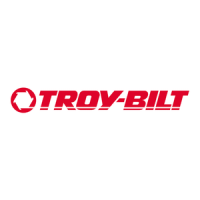Operation
Using
the
Optional
Vacuum
Inlet
Cap
The
optional Vacuum Inlet Cap
(see Photo 4-16) restricts the air
flow inside the processing cham-
ber, freeing extra power for the ro-
tating chipper blade.
Install the Vacuum Inlet Cap
whenever you are tackling large-
scale chipping projects and extra
power is required. The cap also al-
lows you to transport the machine
without having a vacuuming
at-
tachment installed. See Page
21
for instructions on how to install the
Vacuum Inlet Cap.
Chipping
Without
the
Collection
Bag
Operating the chipper without the
collection bag will result in the
processed material being dis-
charged onto the ground. See
Photo 4-17. This may be desirable
in the following circumstances:
• You
may
wish to discharge the
material directly onto your com-
post heap
or
onto an out
of
the way
place on your property.
• You may wish to process green
or
leftover vegetables, without
having the messy debris plug up or
soil the collection bag.
Photo 4-16: Vacuum Inlet Cap.
DANGER
To
Prevent
Personal
Injury
or
Property
Damage:
•
Do
not
allow
hands
or
any
other
part
of
the
body
or
clothing
near
or
inside
the
discharge
deflector,
or
near
any
moving
part.
Cutting
blades
begin
to
rotate
when
engine
starts
and
slow
down
gradually
after
en-
gine
is
shut
off.
•
Do
not
operate
the
machine
with
the
Vacuum
Snout
unless
the
collec-
tion
bag
is
installed.
•
Do
not
operate
on
a
paved,
gravel,
or
hard
surface
when
the
collec-
tion
bag
is
removed.
Material
exits
at
high
speeds
and
may
bounce
from
a
hard
surface.
Always
select
a
level,
earthen
surface
and
stay
clear
of
the
discharge
deflector
area.
Safety
Considerations
When chipping without the collec-
tion bag, make sure that you:
a.) Stay clear
of
the operator's
position behind the handlebars.
b.) Carefully observe all
of
the
safety precautions listed above
and on page 29.
c.) Keep bystanders away from the
operating area.
Using
the
Chipper
Without
the
Collection
Bag
1. Park the machine on a level,
earthen surface.
2. Stop the engine and remove the
collection bag.
3. Start the engine.
4. While staying well clear
of
the
discharge deflector area, feed ma-
terial into the chipper chute
ac-
32
cording to the chipping instruc-
tions described on Pages 30-31.
5. You can also operate the chip-
per with the collection bag in-
stalled - but with the flap open.
This technique allows you to direct
the discharging material in a spe-
cific direction (the debris will be
funnelled out through the open end
of
the bag). This technique is not

